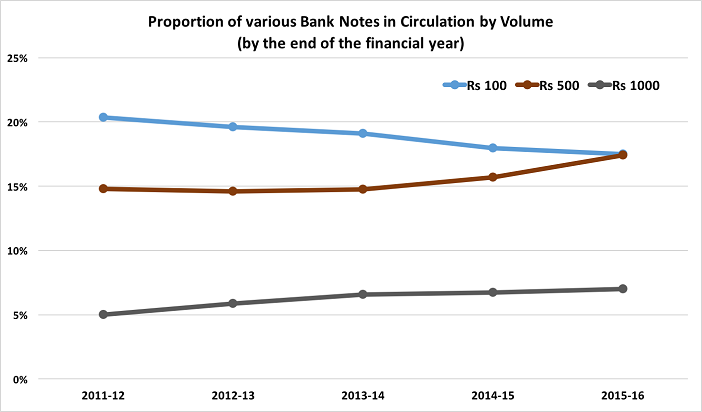[orc]In terms of value, Rs 500 & Rs 1000 notes made up for more than 86% of the notes in circulation, which is more than 14 Trillion rupees (14 Lakh Crores). The printing capacity of the current printing presses in the country may not be sufficient to meet the demand for the new Rs 500 and Rs 2000 notes.
Following the demonetization of the Rs 500 and Rs 1000 notes by the government, there have been long queues in front of banks & ATMs to exchange and deposit the old notes. It might take quite some while for the supply of the new Rs 500 and Rs 2000 notes to match the demand. But what is the capacity of our currency printing presses?
The process of Printing Currency
The Reserve Bank of India (RBI) places indent for banknotes with various printing presses on the basis of an econometric model factoring in the real GDP growth prospects, rate of inflation and denomination-wise disposal rate of soiled notes. Four printing presses print and supply banknotes. These are at Dewas in Madhya Pradesh, Nasik in Maharashtra, Mysore in Karnataka, and Salboni in West Bengal.
The presses in Madhya Pradesh and Maharashtra are owned by the Security Printing and Minting Corporation of India (SPMCIL), a wholly owned company of the Government of India. The presses in Karnataka and West Bengal are owned by the Bharatiya Reserve Bank Note Mudran Private Limited (BRBNMPL), a wholly owned subsidiary of the Reserve Bank. The new Bank Note Paper Mill India Private Limited (BNPMIPL) in Mysuru is a joint Venture between BRBNMPL and SPMCIL, with a production capacity of 12,000 million tonnes. It has commenced commercial production in 2015-16 in a significant step towards the indigenization of production of new banknotes.
Coins are minted by the Government of India. The Reserve Bank is the agent of the Government for distribution, issue and handling of coins. Four mints are in operation: Mumbai in Maharashtra, Noida in Uttar Pradesh, Kolkata, and Hyderabad.
The RBI oversees the currency management in the country including supply & distribution. The RBI also ensures that the clean bank notes are in circulation by continuous supply of clean notes and timely withdrawal of soiled notes.
This is achieved through a wide network of more than 4000 currency chests and more than 3700 coin depots. Currency chests are extended arms of the Reserve Bank Issue Departments and are responsible for meeting the currency requirements of their respective regions.
Rs 500 & Rs 1000 notes make up for 25% by volume & 86% by value
Of the various bank notes in circulation, Rs 10 notes have made up for more than 1/3rd by volume for each of the last 5 years. From 33% by the end of 2011-12, the proportion of Rs 10 notes by volume reached 35.5% by the end of 2015-16. Rs 2 and Rs 5 notes made up for 13% of the notes by volume by the end of 2015-16.
The proportion of the Rs 100 note in circulation by volume has come down from 20.3% by the end of 2011-12 to 17.5% by the end of 2015-16. During the same period, the proportion of Rs 500 note by volume increased from 14.8% to 17.4%. The proportion of Rs 1000 note also increased from 5% by the end of 2011-12 to 7% by the end of 2015-16. By the end of 2015-16, Rs 500 and Rs 1000 notes made up for a quarter of all the notes in circulation by volume, around 22 billion pieces.

In terms of value, Rs 500 & Rs 1000 notes made up for more than 86% of the notes in circulation, which is more than 14 Trillion rupees (14 lakh crore rupees).
21 billion bank notes were printed in 2015-16
The supply of bank notes increased from 17.5 billion pieces in 2011-12 to 21.2 billion pieces in 2015-16, an increase of around 20%. The supply of bank notes decreased by around 10% in 2015-16 compared to 2014-15.

The presses supplied around 6 billion pieces of Rs 500 and Rs 1000 in 2014-15 and 5 billion pieces in 2015-16. In 2016-17, the original indent for Rs 500 and Rs 1000 notes was around 8 billion. If the entire printing capacity is pressed into action, then it might be possible to produce around 23 billion pieces a year (inclusive of all denominations). But with Rs 500 and Rs 1000 alone accounting for 22 billion notes in circulation, it might not be possible to meet the demand for new Rs 500 and Rs 2000 in the short term.



3 Comments
I think, the author answered everything except the question of, what is the capacity of printing 100, 500 and 2,000 notes and how many days or moths it would take to replace the Rs. 14.20 lakh crore banned currency?
Government is printing 2000 rupee note which is two times value of 1000 and four times value of 500 rupee note . It means Government needs lesser time for replacement of old 500 and 1000 value notes . Government is printing 2000 value notes from September 2016 . It means Government has already printed sufficient 2000 value notes for replacement .
It completely says it will take till April or may to complete the demand in circulation but as India is moving from country to a digitalised country. Government will have to face lesser time in completing this chaos situation for farmers or those who can only access through cash as in remote areas